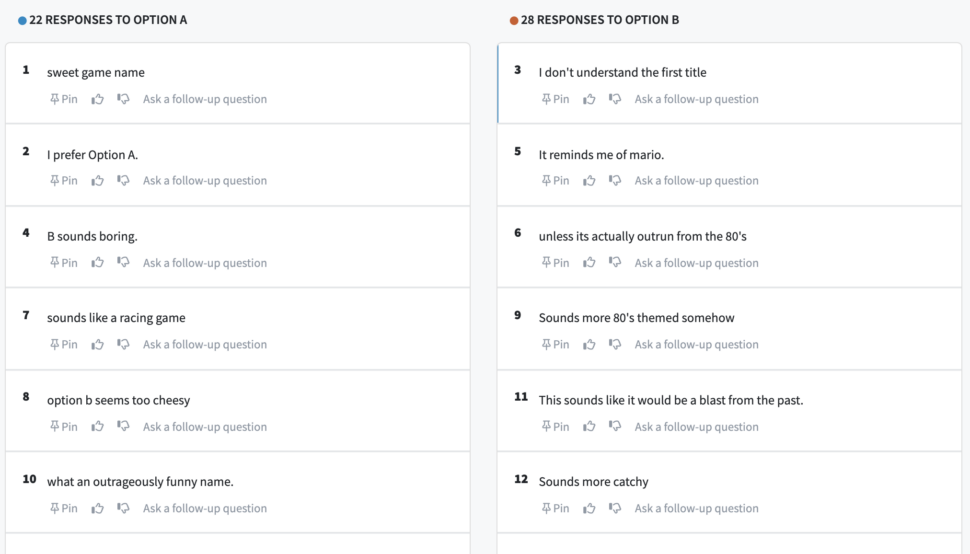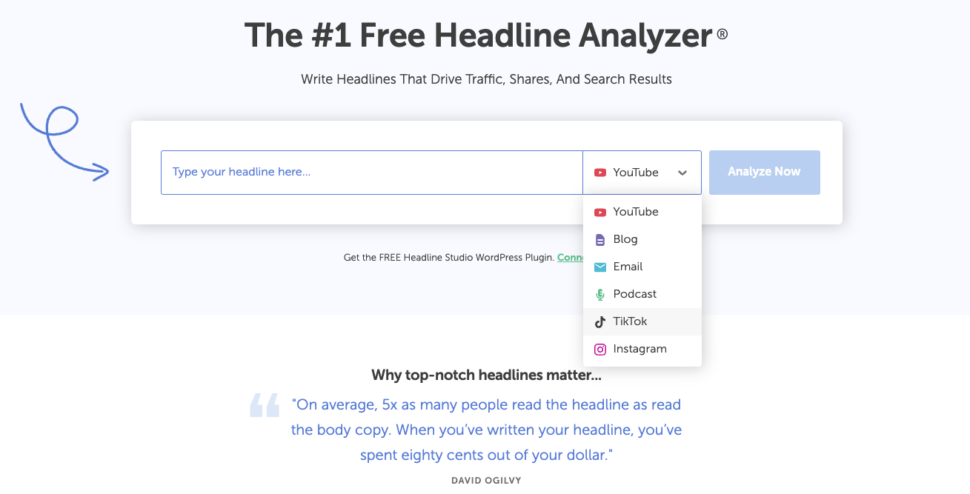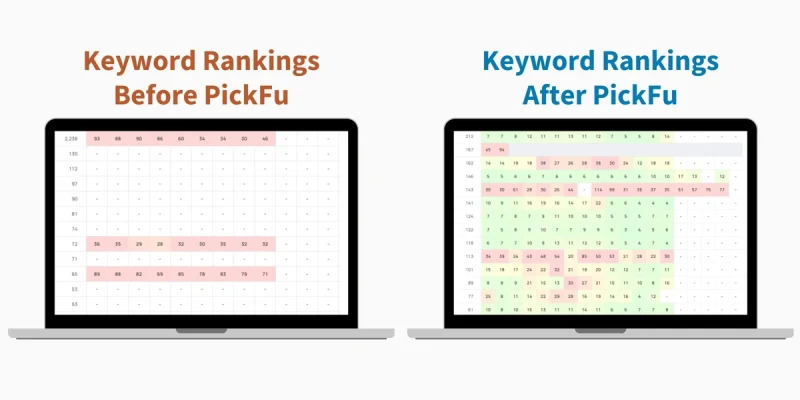Leveraging customer feedback the right way can skyrocket your business’, website’s, or app’s performance.
But it isn’t enough to skim customer reviews on product pages and social media or send the occasional survey.
You need a robust strategy to ensure that you get relevant, powerful customer feedback on your product and branding efforts – without wading through irrelevant, unactionable feedback.
We know this because PickFu has been helping businesses collect and harness user feedback for 26 years!
Here’s our guide on how to collect customer feedback effectively so you can keep customers happy and grow your business.
The customer feedback loop
A customer feedback strategy that provides value is all about understanding and implementing the feedback loop.
A customer feedback loop is the process of collecting, analyzing, and executing customer feedback to improve your products or services. It’s listening to the customer’s voice and making it part of your business processes.
However, you also need to maintain and iteratively improve your feedback collection activities. This continuous process ensures that you’re meeting the needs and expectations of your customers.
Here’s an example of how PickFu helped a client leverage a feedback loop. An app creator polled a group of people in his target audience, asking them to choose the best name for his game. He then tested logo concepts, character designs, and even the donation amount he could expect if he launched a Kickstarter campaign. In this way, he used customer opinions to create value and launch his game on the right foot.
Similarly, you could include the voice of your customer in your decision-making. Using customer feedback loops will help you build products that meet customers’ needs and secure their loyalty.
So, we come to the real question – how can you collect customer feedback seamlessly? Read on for a step-by-step guide on building your customer feedback strategy.
8 steps to build your customer feedback strategy
Let’s dive into how you can generate and analyze customer feedback to get actionable insights for brand design, product development, or any other activity that grows your business.
1. Create a goal for your feedback strategy
The first step to building an effective customer feedback strategy is defining your goal.
Start by asking why you want to collect customer insights.
Is it to learn how best to build and launch a new product, or deciding what to prioritize on your product roadmap? Or perhaps you’re doing market research for an app? Or maybe you’re just wanting to know what people think about your brand.
Take time to dig into the “why” and find a clear purpose behind collecting feedback.
What are some ways that setting a goal will impact your feedback collection strategy?
A goal helps you determine which types of feedback to collect and from whom. It helps you set up key metrics to learn whether the strategy is a success and if the changes you make next lead to concrete improvements.
We’ll look at specific examples of goals and metrics later in the post. What you should understand now is that having goals is essential if you want to craft a good customer feedback strategy.
2. Ask the right audience
Identifying and engaging with the right audience is crucial in the feedback collection process — think of it as the “garbage in, garbage out” or GIGO principle.
You must get feedback from people who are relevant to your business, product, and market for their feedback to have value. When you gather actionable feedback, you’re empowered to make design changes and improvements that make customers happy.
Say you have a SaaS product with features for solopreneurs, mid-sized businesses, and enterprises. If you’re building features for solopreneur users, your feedback should come from them and not your entire customer base.
You can define your audience for feedback collection based on factors like location, income, or education, for example. Or categorize customers based on their subscription level, how often they buy from you, or their persona. And don’t forget to take pain points and behaviors into consideration.
Take it up a notch and use PickFu – a self-service consumer research platform – as your audience research tool to select the right demographic. We have 15 million vetted respondents who are invested in sharing their real thoughts. Understand how different customer segments feel about your business to improve your strategy and refine your product or marketing.
3. Create a feedback collection plan
At this stage, you’ll choose your feedback approach based on your pre-defined goals and audience.
There are two main types of feedback: quantitative for numeric insights and qualitative for descriptive feedback. You can (and most likely should) combine the two to gather valuable ideas for addressing customer pain points.
Here are the types of customer feedback collection you should consider:
- Polls: Polls are useful for gathering quick, targeted feedback from your audience. You can carry out proof of concept testing, packaging design testing, and app name testing (to name just a few use cases) in less than a day with PickFu polls!
- Focus groups: Hold structured discussions with customers to get more in-depth qualitative feedback. You can have live on-site focus groups, which are challenging to set up and more expensive, or you can opt for online ones.
- Surveys: Customer feedback surveys help you investigate a question or problem in-depth. Measure customer satisfaction, or CSAT, to gauge customer loyalty. Or launch an NPS (Net Promoter Score) survey to learn whether customers would recommend your product to others. Surveys are perfect to pre-screen potential customers if you’re doing new product development!
- Product reviews: Your product reviews on Amazon, review sites like G2, and app stores are great sources of feedback. Check reviews frequently to identify what customers like and don’t like.
- Support tickets: Your customer support tickets are also invaluable sources of feedback. Ensure you have a system for your support team to forward useful ideas and pain points to your developers or GTM team.
- Social media: Check social platforms like Instagram, X, Facebook, and LinkedIn for mentions, comments, and feedback. Customers often ask questions via a business’s social media chat feature. And check out forums like Reddit and Quora to get useful insights.
- In-app feedback: If you’re an app-based business, then in-app surveys and prompts for feedback and ratings are critical. They will help you get real-time reactions and identify usability issues.
Each channel offers unique insights, and choosing the right method will depend on how fast you want information and the depth of feedback you need. Next, we’ll explore feedback collection tools.
4. Choose the right tool
Getting actionable product feedback and other customer insights boils down to working with the right customer feedback tools.
The process of collecting feedback can be time-consuming and expensive. It also adds up if your product development or marketing campaigns get delayed because you’re waiting for data.
We might be a bit biased, but PickFu is a great tool for running quick, flexible polls to fit your feedback needs – from Head-to-Head polls (A/B tests) to Open-Ended questions.
Running polls with PickFu solves many problems, like getting a usable response rate and polling the right people. We have a diverse group of 15 million respondents you can segment to get feedback on your brand name, logo variations, app user interface, product functionality, or whatever else you want to test.
The key benefit of working with PickFu is that you get rapid research feedback, which is powerful for anyone who needs to validate their efforts fast. Our respondents are incentivized to answer your questions, and most polls finish within a day (often within an hour).
Other tools to consider are in-app surveys, adding a quick pop-up feedback form on a product page, and generating automatic feedback emails after a purchase.
The best strategy is to combine multiple feedback collection methods to cover all angles – from your target market and potential users to your existing customers.
5. Analyze your feedback
Feedback is only as useful as the insights you gain from it.
Once you have collected your responses, take the time to analyze them and identify any patterns or trends. Look for common themes and areas for improvement.
If you’re using PickFu, every poll comes with AI tools that automatically summarize and highlight the most important findings. The AI analysis also recognizes the role of outliers and suggests next steps to take to improve your offerings. When you have 100 or more responses, this is super helpful for analyzing feedback quickly.
In one case study, we helped an e-commerce brand use audience feedback to optimize its Amazon product listings in a highly competitive space.
The brand saw a significant boost in search rankings and built its brand kit with audience insights. These insights would take weeks to get via a survey or a live A/B test. And even top research tools (including Amazon’s own Manage Your Experiments tool) failed to help the company push its product to the top.
Here are some tips to remember when analyzing your feedback:
- Negative feedback from unhappy customers can provide as much value as positive feedback.
- Don’t just rely on hard numbers. Qualitative data via open-ended questions can be the key to better products and customer retention.
- Use AI to help you organize the feedback into categories or themes based on the type of response. For example, you may group positive, negative, and neutral feedback. You could also find themes based on specific audience groups or product features.
- Don’t ignore customer feedback, even if it seems insignificant. Every piece of feedback provides an opportunity for improvement and can help you stay ahead of your competition.
Analyzing customer feedback ensures you hone in on the areas that can benefit from immediate changes. This way, you’ll streamline your activities to ones that drive the most growth.
6. Act on insights
After collecting and analyzing customer feedback, the next step is to implement changes based on the insights gained.
Prioritizing which feedback to act on first is key. For example, if you were onboarding a new customer to your platform, add a customer effort score (CES) survey to gauge how easy or difficult the process was for them.
Focus on making small changes based on the scores and feedback, and move forward to the next stage. Be sure to have a system to track feedback-driven changes so you can measure the impact over time.
The goal is to continually refine and optimize based on what customers need. You can evolve products and services with this customer-centric process to keep your loyal customers happy and your new ones excited to work with you.
7. Close the feedback loop
The final step in the feedback process is to close the loop with your customers.
Let them know that you appreciate their feedback and show them how it has been implemented. This helps build trust and loyalty with your customer base.
Some ways to do this are:
- Follow up regularly: Keep in touch with customers after changes have been made. This shows that you value their input and are committed to improving the user experience. Additionally, if a customer gives negative feedback, following up with them to address their concerns and offering a solution can turn an unhappy customer into a satisfied one.
- Monitor the customer journey: Use feedback to understand and enhance every touchpoint along the customer’s path. This deepens insight into how changes impact the overall experience.
- Adjust user experience based on feedback: Continually refine your website or app’s UX to ensure it meets customer needs and expectations. This iterative process is essential for staying relevant and competitive.
- Solicit feedback at every stage: Make feedback collection a constant part of the customer journey, not just a one-time effort. This keeps insights fresh and actionable.
- Educate your team: Ensure that every department understands the importance of the feedback loop and how it informs their work. This fosters a customer-centric culture within the organization.
By integrating these strategies into your feedback process, you foster a culture of continuous improvement. This not only enhances the customer experience but also propels your brand towards greater innovation and success.
8. Reiterate and review
A strategy isn’t set in stone.
You should regularly assess your customer feedback strategy to enhance its effectiveness.
Regularly review your efforts and ensure that your feedback collection efforts and product changes lead to happy customers.
Remember, you might need to adapt your approach to engage new customers and prioritize their needs.
And don’t forget about your employees and their insights. Survey your own team members and ask for ideas to remove bottlenecks and keep things flowing smoothly.
Focusing on your customer feedback strategy across your team internally should help you resolve customer issues faster, boost your customer satisfaction score, and see other positive effects.
Conclusion
We’ve covered how important collecting customer feedback is to improve your product, marketing and branding, and other business areas.
But it’s worth noting that a successful customer feedback strategy also strengthens your brand image. People will notice when you ask for feedback after key customer interactions – it shows that you value their contributions and you’re listening.
Your efforts also become evident when your product, service, brand identity, or app serves your audience well.
You can gather feedback quickly and easily with PickFu. Optimize your landing page, choose a better logo, or narrow down the best product design – our respondents will give you unbiased, actionable feedback.
Sign up for a free account to start using PickFu as part of your customer feedback strategy!
FAQs
What is effective customer feedback?
Effective customer feedback is feedback that is actionable and leads to improvements in products, services, or processes. Businesses can directly apply feedback to make specific changes to an app, website, product, or service and create a benefit.
How can technology be used to enhance customer feedback collection?
Technology can enhance customer feedback collection by enabling polls, online surveys, using chatbots to collect feedback in real-time, and offering incentives or rewards for completing surveys. Customer insight platforms can automate the entire customer feedback strategy.









